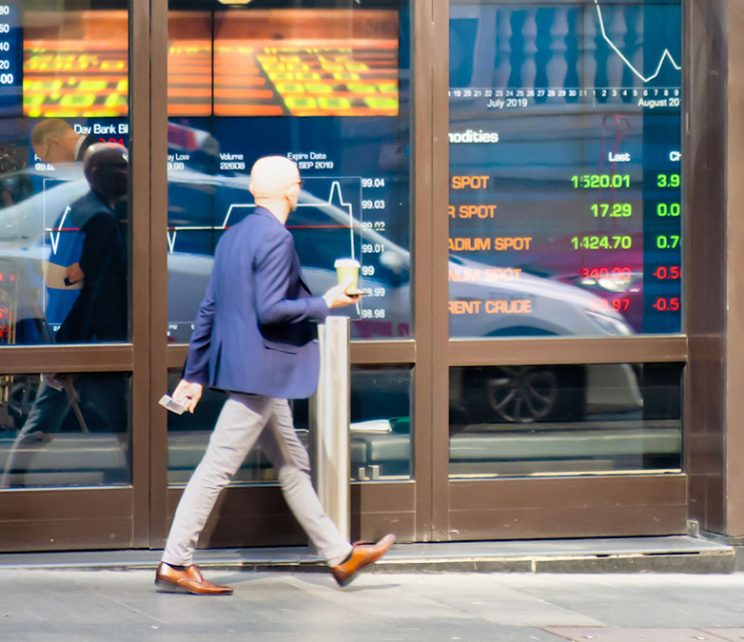
Mainstream Online Web Portal
LoginInvestors can view their accounts online via a secure web portal. After registering, you can access your account balances, periodical statements, tax statements, transaction histories and distribution statements / details.
Advisers will also have access to view their clients’ accounts online via the secure web portal.
The Point
Quick, actionable insights for investors
Australian Equities

Crispin Murray: Four issues driving the economic outlook for Aussie equities
Australian stocks have proven remarkably defensive over the past year, compared to global shares and other asset classes, delivering a 6.5 per cent return in the year to February, says Pendal’s Crispin Murray.
A material decline in shares is unlikely in 2023, says Crispin in his new biannual Beyond The Numbers webinar.
Earnings are on track for 2% growth in 2023 and 1% in 2024, he believes.
“However, if we do get the RBA forced to hike rates far higher than the economy can absorb, and we do get a downturn, then we’re going to see much more material downgrades. But it’s not the scenario we expect.”
Four issues will drive the underlying economic picture for Australian companies, he says:
- The risk of a US recession
- The outlook for Chinese growth
- Interest rates and their impact on the Australian economy
- The growing influence of Australian government policy

What’s driving Aussie equities this week
Quick view
What’s driving Aussie equities this week
THE odds of a 50bp US rate hike next week increased markedly after hawkish comments by Fed chair Jay Powell – but that didn’t last long.
Powell last week told US Congress that if the data indicated faster tightening was warranted, “we would be prepared to increase the pace of rate hikes”.
Stronger-than-expected data suggested “the ultimate level of interest rates is likely to be higher than previously anticipated”, he said.
The comments drove two-year US Treasury yields above 5% for the first time since 2007.
The spread between two-year and 10-year bond yields inverted to -107bp – the biggest inversion since 1980 when then Fed chair Paul Volcker was trying to kill inflation.
However, all this was reversed after the collapse of Silicon Valley Bank (SVB) late in the week, which saw yields fall.

Aussie equities: What we learned in ASX reporting season
Quick view
Aussie equities: What we learned in ASX reporting season
ASX earnings season came to a close this week, delivering a more robust-than-expected picture of the economy.
Here a few things we learned, says Pendal analyst and co-portfolio manager Oliver Renton:
- The effect of higher interest rates is yet to fully flow through company P&Ls
- Early signs of higher wages are showing through in company results, but the full effect could take two-to-three years
- Earnings season did not resolve concerns about the outlook for household spending and consumer confidence.
“At a headline level reporting season appeared quite normal, but there’s a lot going on under the surface,” says Oliver.
“Much-discussed macro drivers are only just starting to come through in actual company earnings.
“The same pressures we have speaking about for the past 12 months are not in the rear-view mirror yet.
“The good thing is that the intersection of those macro forces with company specifics continues to create opportunities.”

Crispin Murray: What’s driving Aussie equities this week
Quick view
Crispin Murray: What’s driving Aussie equities this week

Crispin Murray: What’s driving Aussie equities this week
Quick view
Crispin Murray: What’s driving Aussie equities this week

Crispin Murray: What’s driving Aussie equities this week
Quick view
Crispin Murray: What’s driving Aussie equities this week
A LOW point in the VIX volatility index last week proved to be the signal for a correction in the recent rally.
There was no specific macro news to prompt this. The weight of buying faded and the market shifted to a cautious position ahead of this week’s Fed meeting.
US ten-year government bond yields rose 9bps and the S&P 500 fell 3.4%. Brent crude oil fell 11.1% and is now down for the year to date, as the market worries about a downturn in demand.
China’s re-opening appears to be happening faster than expected.
The iron ore price rose 9.6% as a result, and is helping underpin the Australian equity market.
The RBA hiked rates 25bps, as expected, and struck a more cautious tone on inflation.
We also saw the federal government launch a new energy policy which at first glance looks under-prepared. The policy introduces price controls that would likely make the power problem worse in the future.
There are six big macro issues going into next year:
1. The persistence of inflation — and how tight financial conditions will need to be in response
2. The scale of economic slowdown in the US and developed markets. (Real-time signals are benign, but the yield curve is a very negative signal)
3. The earnings leverage to that downturn — and whether nominal growth buffers earnings
4. Whether markets have already priced in economic downturn. The bear view is that markets bottom during recession, not before. Bulls point to a falling oil price, a weaker US dollar and lower bond yields as evidence of lessening headwinds for equities
5. What China’s economy does as it exits zero covid
6. Whether the RBA can engineer a soft landing in Australia

Crispin Murray: What’s driving Aussie equities this week

Crispin Murray: What’s driving Aussie equities this week
Quick view
Crispin Murray: What’s driving Aussie equities this week

Crispin Murray: What’s driving Aussie equities this week
Quick view
Crispin Murray: What’s driving Aussie equities this week
The medium-term outlook for markets depends on the degree of economic downturn and its impact on company earnings.
But there is debate about how much the downturn will affect earnings, says our head of equities Crispin Murray.
“Historically, recessions have led to an average 20 per cent fall in earnings,” says Crispin.
“But this is often in a low-inflation environment, when nominal GDP (a proxy for corporate revenue) is low.
The bulls argue that three factors may mitigate earnings decline, says Crispin:
-
Companies will benefit from higher nominal growth, supporting revenue and helping cover fixed costs
-
Materials and energy companies will see continued strong earnings, given lack of supply
-
The potential re-opening of China may offset weakness in Europe and the US

Two big ESG themes we saw in ASX reporting season
Quick view
Two big ESG themes we saw in ASX reporting season
Energy security and workplace relations were among the biggest ESG themes in the recent ASX reporting season, says Pendal’s Rajinder Singh.
On the labour front, Rajinder says investors should take a look at a company’s agreements with workers.
“If you’ve got an agreement that’s due for renegotiation in the next 12 months versus one that was signed for five years, that could have a material impact on your forecast growth of your labour costs.”
For energy, security of supply is critical, says Rajinder.
“The other thing that matters for investors is understanding the capital expenditure required to address these issues.
“What’s the capital allocation to these initiatives? And is there an actual measurable benefit for the amount they are planning to spend?”

Crispin Murray: What’s driving the ASX this week
Quick view
Crispin Murray: What’s driving the ASX this week
What did we learn from 2022 earnings season? Our head of equities Crispin Murray points to five things:
-
Pricing power has been a key point of differentiation among companies. “Disappointing results mostly reflect insufficient moves to offset cost pressure, particularly in the building-related sector and companies with European exposure (eg Dominos Pizza). Companies such as Wisetech and Qantas show the value of pricing power.
-
Costs are a headwind to some of the defensive stocks — leading to less defensiveness than expected. We saw this in Endeavour, Coles, Woolworths and Ramsay Health Care.
-
Some cyclicals are not experiencing the weakness many feared, eg Nine Entertainment and some advertising-related names.
-
Companies with cyclical tail winds are performing well. For example the lithium sector remains strong, as does oil refining.
-
The market is liking capital return. New buy-backs from Nine and Qantas were well received.

What’s driving the ASX this week
Quick view
What’s driving the ASX this week
Australian corporate earnings are ahead of expectations halfway through reporting season.
But there are signs companies are starting to bunker down amid uncertainty on interest rates and wages growth, says Pendal portfolio manager Jim Taylor.
About a third of companies have exceeded market consensus for their June 30 numbers, while some 18 per cent have missed, he says.
Bottom-line earnings and free cash flow have been pleasing. But dividends and buy-backs have disappointed, indicating managers are taking a conservative view on the economic outlook, says Jim.
“Boards are taking quite a conservative view on what the next year looks like.
“They’ve taken the opportunity to temper some expectations and preserve some balance sheet capacity and cash.”
Register for our Beyond The Numbers reporting season webinar on Sep 9.
Loading posts...
Loading posts...














